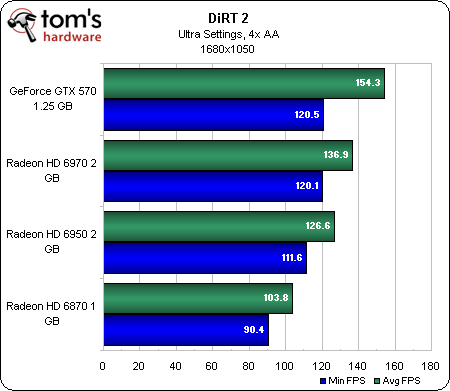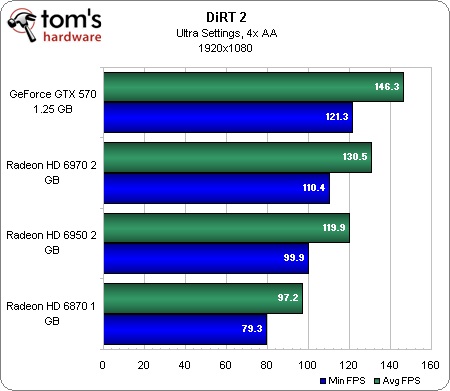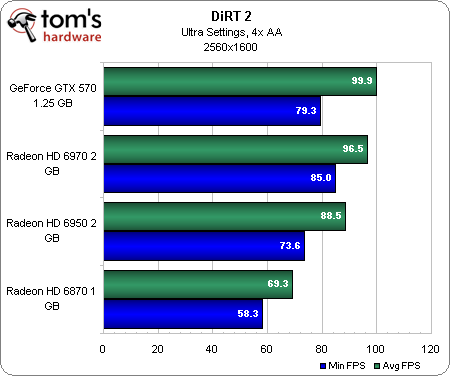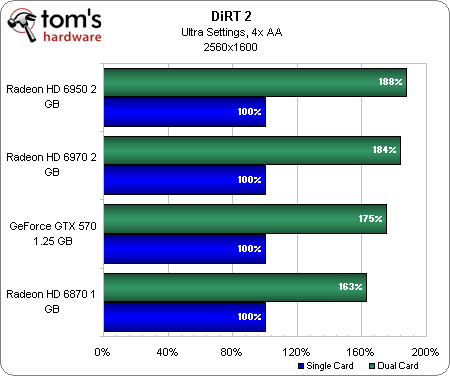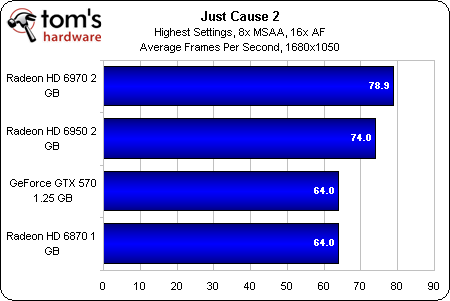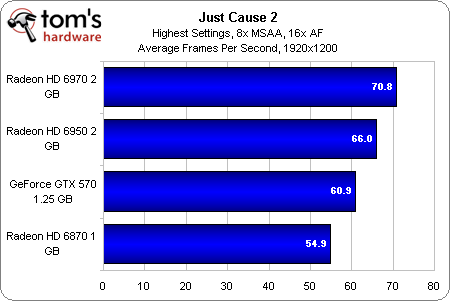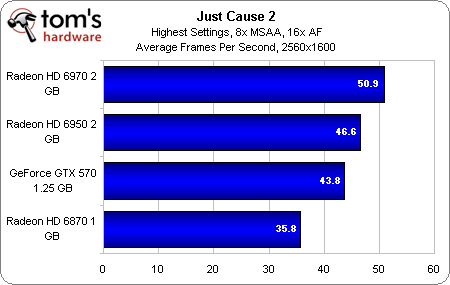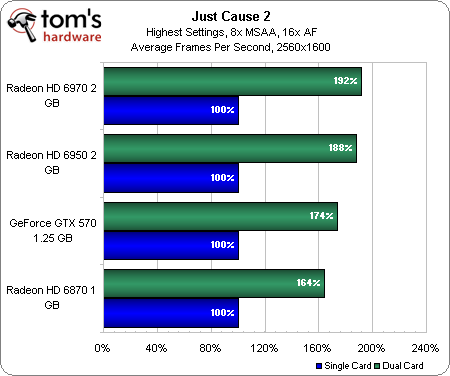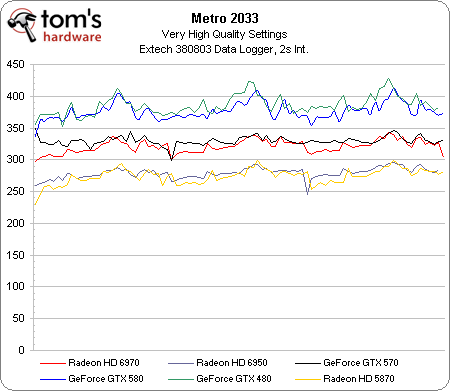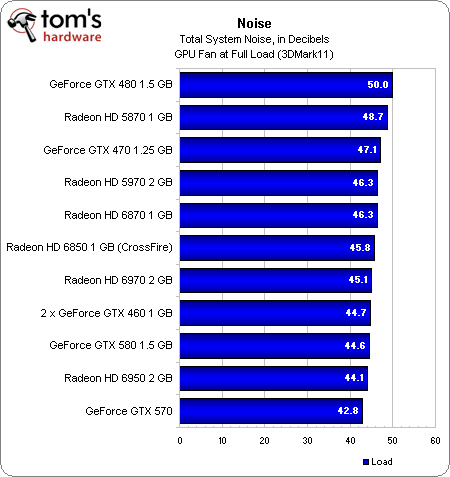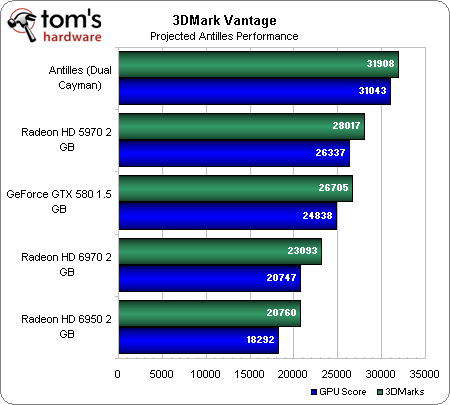|
TopNax |
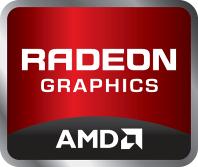
Multi-Card Scaling In DiRT 2 |
|
Nvidia holds on to a lead throughout DiRT 2 testing with its GeForce GTX 570s in SLI, besting the pricier Radeon HD 6970s across the board. As with all of the tests so far (except Metro), you get playable performance even with two Radeon HD 6870s, though. Itís worth reiterating that itís probably not necessary to run a pair of graphics cards with this much performance unless youíre spanning a trio of displays in Eyefinity or Surround.
Nvidia might rule the benchmark results in DiRT 2, but the fact that AMDís cards serve up superior scaling means the GeForce GTX 570ís lead diminishes as you switch from one card to two. |
Multi-Card Scaling In Just Cause 2 |
|
AMDís Radeon HD 6970 and 6950 take first- and second-place finishes at each of our three resolutions, trailed by the GeForce GTX 570 in SLI and AMDís Radeon HD 6870. At 1680x1050, the GTX 570 and 6870s perform similarly. However, as resolution increases, the 6870 cannot keep up, leading the Nvidia card to close the gap on AMDís Radeon HD 6950.
AMD continues demonstrating excellent scaling here. Though CrossFire canít achieve a perfect doubling of performance, averaging a 90% gain is quite respectable, especially since Nvidia is only able to add 74% more frame rate with a second GeForce GTX 570. Before wrapping up the CrossFire and SLI scaling, youíll notice that we didnít include Lost Planet 2 in our comparison. Nvidia prevents us from running the same 8x MSAA setting on both Radeon and GeForce boards, instead exposing its coverage sampled anti-aliasing technology. It simply wouldnít be an apples-to-apples comparison. Why does it enable 8x MSAA in Battlefield: Bad Company 2 and in Just Cause, but not Lost Planet? Good question |
Power Consumption And Noise |
|
Both of AMDís Radeon HD 6900-series cards give us power profiles that look a lot like existing boards in our three-loop logged run of Metro 2033 at 2560x1600 using Very High quality settings, 4x MSAA, and anisotropic filtering. The Radeon HD 6970 is very similar to the GeForce GTX 570, and the Radeon HD 6950 traces very close to the Radeon HD 5870. A closer look at the averages confirms this. The Radeon HD 6970ís average system power in this test is 321 W, while the GTX 570-based system consumes 329 W. The Radeon HD 6950 averages 279 W and the Radeon HD 5870 averages 274 W. When the Radeon HD 6900s arenít in use, they throttle down to a 250 MHz core clock and 150 MHz memory frequency, saving power.
Nvidia stepped it up with regard to the thermal and acoustic management of its high-end cards. After the poor reception of GeForce GTX 480, both the GeForce GTX 580 and 570 were able to top performance charts and come in at the bottom of our noise benchmark. AMDís Radeon HD 6970 and 6950 also show well in this regard. Though the GeForce GTX 570 remains the quietest card in our comparison, itís followed closely by the Radeon HD 6950. A couple of other configurations slide in ahead of the 6970, but itís also a very subtle presence in any performance PC. The one caveat Iíll throw down hereóand this really has to apply to any gaming machineóis that you want these cards at least three expansion slots apart if youíre planning to go with a CrossFire setup, leaving enough room for airflow between the first and second boards. Should you cram them back-to-back, expect much less desirable acoustics. We measured a pair of Radeon HD 6970s at 53.9 dB(A), compared to two GeForce GTX 570s at 49.6 dB(A) in such a not-recommended configuration. While I've been talking about four slots worth of expansion dedicated to dual-card setups up until now, it's really more realistic to think of any CrossFire or SLI array as needing to populate five slots. |
Conclusion |
|
The fact that, by AMDís own admission, its new single-GPU flagship goes up against Nvidiaís second-fastest board is probably not what AMDís loyal fan base wanted to see. And it again puzzles me to see such unrepresentative naming in play here. Think Iím off my rocker? That anyone reading Tomís Hardware should simply ďknow betterĒ and not worry what these cards are called? Just try telling me this slide from AMD's press deck doesnít look completely off:
Had Nvidia launched GeForce GTX 580 with a slide like this showing GeForce GTX 480 up top, the world would have come to an end, Iím sure. Nevertheless, now weíre waiting for a Radeon HD 6990, which AMD tells us to expect some time in Q1. Thatíll be Antilles, a dual-Cayman board that weíd expect to perform something like a pair of Radeon HD 6950s in CrossFire, so long as AMD doesnít have to make any clock rate concessions due to excessive power demands. We're hoping that the advent of PowerTune prevents such a backwards step.
Should that come to pass, weíd be looking at a board that beats out Radeon HD 5970. Thereís no telling what pricing on that will look like, but if AMD arms it with 4 GB of expensive GDDR5 memory, itís going to be expensive. If the company doesnít, instead matching each GPU up to 1 GB of GDDR5, itíll suffer in the high-resolution, high-detail workloads a flagship product should dominate. I guess we answered our own question there, didn't we? Expensive flagship, incoming. The Here And Now Thatís a story thatíll unfold in the next three months. More immediately, we have the Radeon HD 6970 and 6950, competing against the GeForce GTX 570 and GeForce GTX 470, respectively. Official pricing from AMD is pegged at $369 for the 6970 and $299 for the 6950. Thatís actually slightly less expensive than I was expecting to pay for the high-end board, and a little more than I would have wanted to see the lower-end board selling. Letís start with the Radeon HD 6950. While itís true that Cayman seems to be a more forward-looking DirectX 11 architecture than Cypress, and the ability to use four independent display outputs is good (as is Blu-ray 3D support), itís still hard to ignore the fact that vendors are clearing out inventory of the Radeon HD 5870, available for as little as $260 after rebates. At the same time, GeForce GTX 470s are going for $250. The 470 doesnít stand up as well to high resolutions, but itís still a decent deal if youíre gaming at 1920x1080. The Radeon HD 5870 is going to disappear soon, and we're not sure how much longer the 470 will retain its position in Nvidia's lineup, given the recent emphasis on GF110. After all, it doesn't make a ton of sense to keep making new GF100s with attention shifting to the newer GPU. Until theyíre gone, look to them as decent deals. Picking up last yearís graphics technology, which in this case is still very modern, is a great way to save some money. As for the Radeon HD 6970, it should be selling for $20 more than a GTX 570. Based on its display outputs alone, that makes AMDís card worth the Andrew Jackson to me, personally. Otherwise, the two cards trade blows, with the GTX 570 faring better at 1680x1050 as AMDís Radeon HD 6970 retains more of its performance at 2560x1600. Donít lose track of the fact that you can find a pair of Radeon HD 6850s for the same $370 youíd spend on a 6970, though. Those 6800s have the same set of display outputs, UVD 3, and morphological anti-aliasing supportóand theyíre notably faster. If you can accommodate two cards, that is one way to go. The other is a pair of GeForce GTX 460s, which are faster in some apps and slower in others, but sell for around $190, bringing the bottom line to $380. Considering 6900s In CrossFire But wait, thereís more. What about the Radeon HD 6900s in CrossFire? After all, AMD claims to have made some notable improvements to its scaling. Youíre only going to buy two high-end graphics cards if youíre running at the top resolutions with visual details maxed out. Thatís where the 2 GB frame buffers featured on both 6900-series cards come in handy. In many cases, two $300 Radeon HD 6950s outperform a pair of $350 GeForce GTX 570s, saving you $100 total for better frame rates. Itís hard to use the word value when youíre talking about $600 worth of graphics cards, but in this ultra-high-end space, two 6950s trump GTX 570s in bang for the buck. Take a look back at the scaling figures. In the past, SLI would have dominated. However, we have to take AMD's word that it improved CrossFire-based performance in its driver. Comparing to the Radeon HD 6870 isnít really fairóthat boardís smaller frame buffer makes it unsuitable for 2560x1600 with anti-aliasing enabled. With that said, though, AMD plans to roll those optimizations into its other cards as well, so there should be a speed bump in store for folks running CrossFire on older cards. |
|
Home††† Previous†††† AMD page†††† Intel page†††† Dell page†††††† |
|
Home††† Previous†††† AMD page†††† Intel page†††† Dell page††††† |
